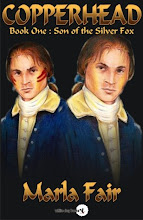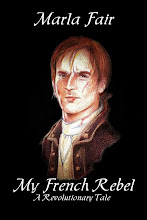

It's finally time to retire Captain Kirk and friends, though I have enjoyed seeing them on the blog for a few months. I haven't been AWOL this time (the last post was in August, sheesh!), I've been busy. If you check out my websites you will see I have two new books for sale - one is a kids' book and the other is a novel based on the life of this young man.
John Johnston was born in 1775 in County Fermanagh, Ireland, in the small village of Enniskillen. His father was Stephen Johnston. His mother, Elizabeth Bernard. In Concerning the Forefathers Being a History of Col. John Johnston and Col. Robert Patterson by Charlotte Reeve Conover, it is stated that Elizabeth was ‘a girl of French descent, of a rich and influential family, and of a liberal education for those days. Her grandparents, having emigrated from France to Ireland, settled in a home not far from Ballintra and left her at their death a fortune of ten thousand pounds sterling.’[1]
Today’s equivalent would be nearly three million dollars.
This wealth may explain John Johnston’s own emigration at the age of 11. According to the same book, he charmed his mother into allowing him to come to America with a kindly priest, who was a family friend. The priest served as an onboard tutor for boy. Once in America, John lived with the family of Judge John Creigh. Judge Creigh was a bit of a Renaissance man, serving in turn as judge, doctor, tutor and owner of a mercantile establishment. John Johnston’s residence in Judge Creigh’s home was a great influence on the course his life eventually would take.
In the early 1790s, inspired by the tales of the west told by soldiers returning from the frontier, John and Judge Creigh’s son, Samuel, set out on their own. They opened a mercantile establishment in Cincinnati, Ohio where they sold ‘slops and goods’,[2] and then, in time, began to ferry the goods to the army and to travel with them. After they parted ways, John Johnston attempted to start a store with his brother, William. The venture failed, and John returned to Philadelphia and what would become his destiny.
In 1802, after working as a clerk for the Prothonotary of the Supreme Court, John Johnston was appointed as one of the first US factors to the Indians. The wars had ended, and many of the Indian tribes wanted to trade with the United States government instead of the British and French. At Little Turtle’s request, one of the first factories, or stores, was established at Fort Wayne in the Indian Territory (present day Fort Wayne, IN). John Johnston and his bride arrived there in September of 1802 to begin a stay that would last slightly over ten years.
In 1809 John Johnston was appointed Indian Agent upon the dismissal of William Wells. The majority of the words spoken by John Johnston concerning Wells in this book are paraphrased versions of direct quotes. John did not trust Wells and considered him a ‘rapacious unprincipled character’.[3] He warned anyone who would listen that Wells as a ‘bad’ man.[4] It seems the dislike was mutual. Letters show that Wells complained of John Johnston and sought ways to undermine his authority. It is the author’s personal opinion that something transpired between the two men of a deeply personal nature. In all of my study of John Johnston’s papers and letters, there is no other individual of whom John speaks with such blatant aversion. Hence the matter of my book as concerns the implications of Wells’ duplicity in the robberies, lies and fire.
In 1811, complaining of illness, John Johnston resigned from his post at Fort Wayne. Seven years earlier, in 1804, he had fulfilled his dream of buying the land at Upper Piqua. The first time John saw the farm site he determined to purchase it at any price. It consisted of 250 acres of rich dry prairie covered with grass and skirted with beautiful woods, an unusually large and never failing spring of pure, cold water coming out of the second bank of the Miami, a house that sits 40 feet above the first bottom on the west side of the river, a half mile below the mouth of the Loramie Creek.[5] He wanted nothing more than to be a gentleman farmer. That dream came to be, but was put on hold when hostilities broke out between the United States and Great Britain in June of 1812 and war was officially declared.
During the War of 1812 the homestead at Upper Piqua –including a large log house, a springhouse, double-pen barn and other buildings—became a haven for Indians loyal to the United States government and the American soldiers. Before heading west and north to relieve Fort Wayne in September of 1812, William Henry Harrison’s army was encamped on Johnston’s 250 acres. It was there that Harrison received his commission as General of the Army of the Northwest. At one time, Harrison sent the members of the Delaware nation to John Johnston for protection. They numbered 900 Indians. The people in the local town of Lower Piqua were rather boisterous and vocal in their opposition to the idea, even going so far as to petition the governor at the time to remove the savages. John Johnston was labeled more than once an ‘Indian sympathizer’—and that was by his supporters![6] He was, according to the native population of the state, an honest man who did his best to obtain justice for them.
During the war, John Johnston was appointed Indian agent to the Shawnee nation. Later on, in 1816, the Wyandot, Seneca and Delaware were added to his jurisdiction. The brick house at Upper Piqua, constructed during the war years, became an Indian Agency and continued as such until 1829; one year after Andrew Jackson became president. Jackson was a Democrat and John Johnston, a Whig. In 1829 the agency passed to a new agent and, for the first time in nearly three decades, John Johnston was no longer a public man.
Over the next few years John channeled his considerable energy and abilities into assuring the progress of the canal through Ohio. In 1825 he had become a Canal commissioner. He also had a keen interest in progressive farming and was a strong supporter of education for all. John was a member of the traveling board of the West Point Military Academy (where his son, Robinson, attended) and was a founding member of Kenyon College in Ohio.
John Johnston lived to the ripe old age of 85. He died in 1861, just one month short of the outbreak of the Civil War. As a young man he had seen George Washington with his own eyes. On his last trip to Washington DC (the city in which he died), he may have witnessed the construction of the new dome of the Capitol building, and Abraham Lincoln occupied the White House.
John’s body was brought back to Upper Piqua where it was interred in the family cemetery next to his beloved wife, as per his wishes. His tombstone reads:
Colonel John Johnston. b. 3-25-1775, d. 2-18-1861. Served the US in various important trusts for a period of forty years, by his own desire, lies buried here close by the side of his beloved wife, Rachel, hoping to rise together at the resurrection of the Just. Life’s labor done, securely laid in this their last retreat, unheeded o’er their silent dust the storm of life shall beat.
Colonel John Johnston. b. 3-25-1775, d. 2-18-1861. Served the US in various important trusts for a period of forty years, by his own desire, lies buried here close by the side of his beloved wife, Rachel, hoping to rise together at the resurrection of the Just. Life’s labor done, securely laid in this their last retreat, unheeded o’er their silent dust the storm of life shall beat.
In the Midst of Danger is the story of John and Rachel Johnston's early years in Fort Wayne, IN. According to John Johnston '‘every means that malice and disappointment could suggest’ were employed against him' during his time as a US Factor at Fort Wayne. As the author, I found I needed no imagination to invent the action of the tale - it was all there and completely true.
If you are interested, the book can be picked up a http://www.lulu.com/content/paperback-book/in-the-midst-of-danger/7831147 Or you can buy it from me by check or paypal via this email address: dfair@woh.rr.com
All profits from the sale of the book go to the Piqua Historical Area and Johnston Farm, which is the house and land owned and lived in by John and Rachel from 1811 tp 1848. Times are tough and we have to raise 1/3 of our operating budget for the coming year, which amounts to approximately $70,000. Buy a book, enjoy a good read and a rollicking adventure, and help save the site!
[1] Charlotte Reeve Conover, Concerning the Forefathers: Being a History of Col. John Johnston and Col. Robert Patterson (Published in cooperation with NCR 1905) 20
[2] Leonard U. Hill, A Reproduction of a Scrapbook, 117
[3] John Johnston to William Eustis, letter, November 6th, 1810
[4] ibid
[5] Leonard U. Hill, John Johnston and the Indians in the Land of the Three Miamis,(Stoneman Press, Columbus, Ohio 1957) 42-45
[6] Charlotte Reeve Conover, Concerning the Forefathers, Introduction
[2] Leonard U. Hill, A Reproduction of a Scrapbook, 117
[3] John Johnston to William Eustis, letter, November 6th, 1810
[4] ibid
[5] Leonard U. Hill, John Johnston and the Indians in the Land of the Three Miamis,(Stoneman Press, Columbus, Ohio 1957) 42-45
[6] Charlotte Reeve Conover, Concerning the Forefathers, Introduction






No comments:
Post a Comment